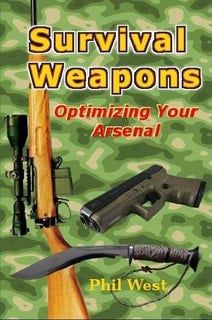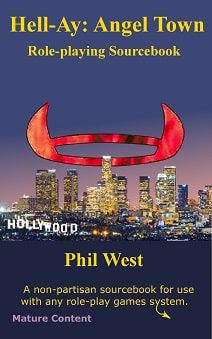Remove the HMMWV from Iraq
In Combat losses may be unavoidable. Waste is NOT!
Since its inception, a common theme in Scrapboard articles has been the need for better defences for logistical forces such as convoys.
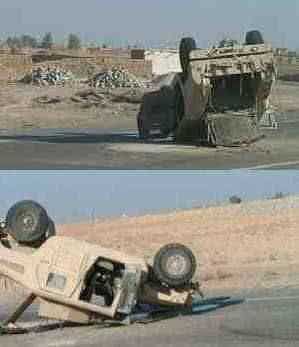 ...the non-linear battlefield may have front lines, but they will be circular, and will be around pockets of strong enemy influence, as has already been detailed. The real difference is that while there are front lines, there no safe rear areas, since lines of communication and supply are often the guerrilla's preferred targets. Therefore one of the primary objectives of the counter-guerrilla forces is to prevent the guerrilla harassing the lines of supply and communication.
...the non-linear battlefield may have front lines, but they will be circular, and will be around pockets of strong enemy influence, as has already been detailed. The real difference is that while there are front lines, there no safe rear areas, since lines of communication and supply are often the guerrilla's preferred targets. Therefore one of the primary objectives of the counter-guerrilla forces is to prevent the guerrilla harassing the lines of supply and communication.
Victory in a counter-guerrilla campaigns has often been a contest of keeping a nation's arteries open while denying the insurgent his ability to move or supply himself.
The doctrine of the guerrilla is to flee from the strong and attack the weak. Small or poorly armed convoys are more likely to be attacked than large well armed forces. Civilian traffic and “soft” military units will be the targets of choice. The solution is for “non-front line” units to become stronger and harder.
On average, one American soldier has died for each day of the Iraqi occupation.
While emails about their heroism and dedication circulate, what is ignored is that many of these deaths could have easily been avoided.
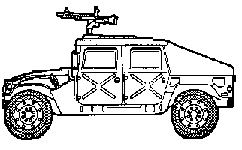 The vast majority of US military personnel are traveling around Iraq in versions of the HMMWV light truck or HMMWV armament carrier.
The vast majority of US military personnel are traveling around Iraq in versions of the HMMWV light truck or HMMWV armament carrier.
Insurgents know that HMMWVs usually contain Americans and therefore they are priority targets for any aggression.
I don't have any specific figures, but browsing the news reports suggest that a very significant proportion of our losses have been from personnel traveling in HMMWVs.
The HMMWV armament carrier was designed to offer its four-man crew some protection against shell splinters and small anti-personnel mines. Some of the later models also offer some protection against small arms fire, but the original armament carrier was not intended to be bullet-proof.
In Iraq, however, the usual weapons of aggression are RPGs and large command-detonated mines.
Weighing around 3 tons, some HMMWVs have been overturned and burned by angry mobs.
Others have fallen victim to grenades or molotovs thrown through their open chest-height windows.
The army's response to this has been to try and increase the protection levels of the HMMWV. Various field-improvised kits have been tried but the weight of these has often overtaxed the suspension of the vehicles.
The HMMWV has a 5/4 or 1¼ t cargo capacity, so 900lbs or more of armour is a significant burden.
The Army has asked for $239 million for new purpose built up-armoured HMMWVs that will cost $250,000 each and are not expected to start arriving till 2006. These are expected to have increased mine-resistance and be proof against AP rifle rounds but will still be vulnerable to RPGs and the large mines commonly being used in Iraq, so in effect offer no practical increase in protection.
The army needs to accept that the HMMWV is not a suitable platform for operation in the Iraq theatre.
Until this is done it will continue to waste the lives of brave soldiers needlessly.
Rather than patrolling in easily destroyable HMMWVs, our troops should be mounted in armoured vehicles such as the Warrior, Bradley and M113.
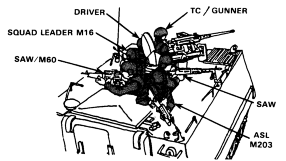 The M113 is the preferred platform since its large roof hatch provides good situational awareness and allows an armed soldier to survey each quadrant. The weight of the M113 is about the same as that of a civilian truck, so the vehicle will encounter few problems with weak bridges.
The M113 is the preferred platform since its large roof hatch provides good situational awareness and allows an armed soldier to survey each quadrant. The weight of the M113 is about the same as that of a civilian truck, so the vehicle will encounter few problems with weak bridges.
I believe there are about a thousand M113s being used currently in Iraq and they are proving to be very successful.
A brand new M113 costs only $550,000 and can carry 2+11 men. This is considerably less than the cost of the several new but less capable HMMWVs that would be needed to carry a squad.
The army already has a stockpile of 13,000 M113s that are already “brought and paid for” and many of these could be deployed to Iraq.
In Vietnam, an RPG penetration of an M113 was estimated to have only a 0.8 chance of causing a single casualty. Only one in seven hits managed to penetrate, so the chances of each hit causing a single casualty was less than 12%.
More recently manufactured rounds for the RPG are doubtless more effective than those in the 1960-70s but M113 armour has improved too.
Many nations use appliqué armour on their M113s which protects them from RPGs and automatic cannon fire.
Oddly, US Army M113s can be fitted with such armour but the army refuses to do this, instead wasting money on up-armoured HMMWVs.
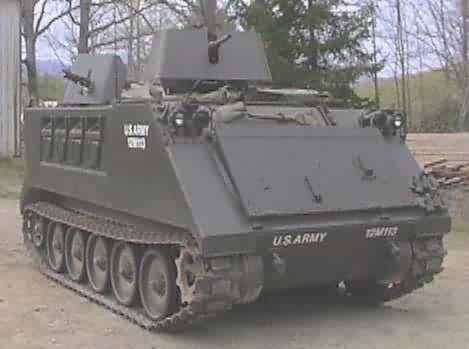 In urban situations, the M113's better armour and situational awareness make it harder to attack. It has the capability to climb across improvised barricades such as parked cars.
In urban situations, the M113's better armour and situational awareness make it harder to attack. It has the capability to climb across improvised barricades such as parked cars.
The M113 is similar in length and width to a HMMWV, but can turn on the spot, so is less likely to get trapped in narrow streets.
The M113 also has superior cross-country performance, allowing it to patrol areas that a HMMWV could not reach.
In rural environments, guerrillas will often attempt to take refuge in hard to reach areas. The capability of the vehicle to easily travel off-road also makes it harder to attack it with Landmines.
The current situation in Iraq is by no means a “peacekeeping” mission.
It is a counter-guerrilla operation and such operations need combat vehicles.
The idea that vehicles need to appear “non-aggressive” is simply nonsense.
If you don't want to appear aggressive you don't have the army out on the streets in the first place!
A HMMWV plated in improvised armour and mounting a machine gun does look aggressive but the enemy also knows that it is really weak and vulnerable.
True armoured vehicles like the M113 not only look tough but are tough. Many attackers will think twice about tackling them because they know that the odds are they will come off the worse. Having such vehicles on patrol will therefore actually reduce the likelihood of violence.
The army has also deployed its new flagship vehicle the LAV Stryker in Iraq.
Each Stryker costs $3 million, carries 2+9 men and weighs around 19 tons.
Much of this weight is taken up by high-tech devices, so the actual level or armour protection is quite low.
As a wheeled vehicle, it is about 28% less weight efficient than a tracked vehicle of similar size or capability. This means the Stryker has to be bigger, heavier and less well protected.
The Stryker's resistance to mine and RPG attack is still in doubt. The LAV Strykers sent to Iraq were fitted with a cage defence (which the army has renamed “slat armor”) but crews used the space under the cage for baggage.
During the RPG attack in Mosul, 28th March 2004 the bags held in the cage were ignited and the cage held the burning items in place and provided a good airflow.
The vehicle was written off by just two RPG hits.
In an urban environment, enemies will be able to get close enough to specifically target the tires with various means of attack.
Bulk and high ground pressure make the Stryker inferior to the M113 in cross country performance on most terrain.
Strykers in Iraq are currently being used to escort convoys, mainly in the northern regions where the likelihood of convoy attacks is lower.
The Stryker's theoretical 62 mph top speed was soon found to be unsafe for such a high top-heavy vehicle, so speed is currently restricted to 45 mph, the same as a Bradley and just a few mph faster than an M113A3.
The driving position of the Stryker only allows the driver to drive with his head out of the hatch or using the periscopes. At high speed these options are either unsafe or uncomfortable.
Compared to the Stryker there are certainly alternate road security vehicles that are faster, better protected, better armed, more compact and/or cheaper.
Convoy security is an important aspect of a counter-guerrilla campaign. Troops in Iraq need a vehicle that can accompany and defend convoys.
A convoy escort vehicle needs to be able to keep up with a convoy without slowing it down, which means a good cruising speed.
On good roads most military and commercial trucks can reach 55-58 mph and it is understandable that crews wish to travel at speed to reduce the time they have to spend in danger areas.
An escort vehicle that requires the convoy to travel slower than it can may be seen as a mixed blessing.
Acceleration of an escort vehicle is also an important requirement. If a vehicle stops to over-watch an overpass or other potential trouble spot it needs to be able to catch up with its charges afterwards.
An escort vehicle also needs to give its crew a reasonable chance against mine and RPG attack, and preferably be able to survive such an attack with only minor or easily repaired damage.
If we look at the current candidates in the inventory:
The HMMWV has sufficient speed and acceleration to keep up with convoys but has proven woefully inadequate in the important consideration of crew protection.
Light tracks such as the Bradley and M113 have a good level of protection but I have concerns about their cruising speed and acceleration. Top speed of the M113A3 is given as 41 mph and 0-20 mph acceleration as 7.8sec. Proposed HED versions of the M113 may be a little better but still may not be sufficient for convoy escort on good roads. M113s are best used for non-escort patrols and pre-convoy sweeps of likely attack areas.
The LAV Stryker has insufficient protection and trouble with rollovers has had it speed-capped. They are also expensive and for political reasons many commanders may feel wary of risking them to enemy action.
Guntrucks
The solution to the problem of convoy escort is an old and proven one.
We need to revive and update the guntruck concept that worked so well in Vietnam. The guntrucks or armored convoy escorts (ACEs) were created because machine gun-armed escort jeeps were found to be too lightly armed to be effective against a serious ambush.
A true truck could carry a formidable warload of weapons, armour and fighting men and still keep up with the rest of the convoy.
Armour assured the crews' safety during the vital first few seconds of an ambush and allowed them to bring their heavy firepower to bear on the enemy.
Guntrucks used in Vietnam can be divided into three basic types:
Modern 2.5 ton and 5 ton trucks can have their cabins armoured and armoured fighting compartments created in the cargo area.
Protection can be provided by plate armour, sandbags and properly used slat armour (without baggage or other flammables beneath it). ERA may also be an option.
Ideally the truck cab would be an armoured unit but failing that, add sandbags, armour and have the crew wear heavy body armour.
Guntrucks for service in Iraq are most likely to be of the “fighting box” configuration, although it is possible that parts of damaged Iraqi BMPs, BRDMs, MTLBs and BTRs could be utilized. It is likely that many modern guntrucks will make use of Mk-19 grenade launchers as well as machine guns. The 7.62mm minigun and newer 5.56mm minigun is another possibility. Hand-held weapons such as M72 LAW, M203 and AT-4/M136 can supplement firepower. Recoilless rifles such as the 106mm M40 and Russian 73mm SPG-9 could also be used for defence suppression.
If necessary, sloped mesh roofs can be fitted over the fighting compartment to keep out grenades and other thrown missiles, although the guntruck is a vehicle for the highways, not urban terrain.
A dozer-type blade for clearing obstacles would also act as a frontal shield.
The South African Casspir mine-protected truck has provision to mount a machine gun firing through the windscreen in addition to the turret on the cab roof.
Ralph Zumbro has suggested that Claymores could be mounted on the vehicle's armoured sides.
The mine resistance of large vehicles such as trucks can be easily be increased by applying the simple but proven techniques developed in Rhodesia and South Africa :
- Reinforcing and shaping the vehicle underside. For some trucks a V-section floor unit was built and fitted to the rear tray for troop carrying.
- Modifying the wheel arches to deflect blast. Mild steel plating was often used because it did not splinter.
- Fitting roll bars.
- Fitting all seats with over-the-shoulder seat belt harnesses.
- Filling truck tires with water to quench the explosion. A truck tire might contain c100 litres of water introduced by a Schrader valve and then pumped up to 3 bars pressure.
The Rhodesians and South Africans were to eventually develop purpose designed mine-resistant vehicles but measures such as those detailed above drastically reduced casualties and damage when applied to conventional vehicles such as Unimogs and Bedford RM and RL series trucks.
Tires are a vulnerable area on any wheeled vehicle. It should be possible to partially protect non-steering wheels by armoured skirts, and some vehicles have incorporated defences for the steered wheels. Guntrucks in Vietnam don't appear to have bothered, probably because mud build up was a problem. There is also potential that such structures could trap mine blast, although there are ways to design the skirts to avoid this.
HMMWV Failures:
Guntruck Images and History:
The bottom line is that the HMMWV is not a suitable vehicle for operation in Iraq. Far more suitable vehicles are available:
- For non-escort patrols, operations off-road and operations in urban areas light tracks such as the M113 should be used.
- For convoy escort, guntrucks based on 2.5t and 5t trucks are more capable platforms than either HMMWVs or Strykers.
The use of HMMWVs has contributed to the deaths and maiming of dozens, possibly hundreds of brave servicemen and most of these could have been avoided.
Not only is the HMMWV unsuitable for operation in Iraq, it is unnecessary since better vehicles are available.
Further unnecessary deaths will occur until the HMMWVs are withdrawn from service in Iraq and more suitable vehicles used instead.
So far, I've written from the American perspective but other armies are just as much at fault.
The British army (which should really know better!) is moving around in Land Rovers and has taken casualties from RPGs and mines as a result.
Against the weapons that it is facing in Iraq, the HMMWV is simply a deathtrap.
Reducing the use of HMMWVs in Iraq will be a major contribution to reducing casualties. Every supply ship that docks in Iraq should be carrying HMMWVs out on its return trip.
If you agree that the use of inappropriate vehicles such as the HMMWV and Stryker are putting our servicemen's lives at risk unnecessarily, write or email your senator, MP or representative.
Please feel free to circulate this webpage and drum up support for withdrawing the HMMWV.
Below is an extract from the current Field Manual FM 55-30 “ARMY MOTOR TRANSPORT UNITS AND OPERATIONS”(last revised Sept 1999) which includes a description on the use of guntrucks. Note final line about “our most precious resource--our soldiers”.
Seems this has been forgotten.
O-6. GUN TRUCKS. Logistical convoys cannot always depend on military police support or added firepower. To provide more firepower for a convoy, units developed the gun truck. The purposes of a hardened gun truck are to--
- Provide a base of fire.
- Help counter enemy attacks.
- Increase survivability of the convoy.
The gun truck is equipped with a crew-served weapons system, preferably in a protective position. In Vietnam this principle worked well and provided convoys a means of self-defense.
Deploy the gun truck in the convoy where it can best provide the needed firepower. If adequate communications assets are available, they should be located with the gun truck and the convoy commander. This enables the convoy commander to call the gun truck forward when needed. (A predesignated signal is required to bring the gun truck forward and inform the crew-served weapon system personnel of the enemy location.) If communications assets are not adequate, pyrotechnics may be used to signal the gun truck to move forward.
The gun truck should not be pulled up right on top of the enemy location. The crew-served weapons on the gun truck can cover a significant distance. Therefore, the vehicle should be situated where it has a clear field of fire to engage the enemy with the maximum effective range of the weapon. If necessary and if available, multiple gun trucks can be used. When using multiple gun trucks in a convoy, overlapping fields of fire greatly increases the convoy's chance of survival.
NOTES:
1. Based on availability, types of weapon systems, and size of the convoy, the placement and number of gun trucks may vary. With company-size and larger convoys, a minimum of two gun trucks should be used to provide overlapping fire. One gun truck for every eight vehicles in the convoy is recommended.
2. Consider using the MK19 or M203 to penetrate prepared defensive positions since small arms fire may not be capable of destroying enemy positions.
Figure O-5 is an example of the gun truck used in Vietnam. It shows the armor plating used for the windshield and doors of the vehicle. It also depicts the layout of the weapon systems mounted on the vehicle with identified firing ports and specific areas of responsibility.
O-7. BALLISTIC TEST RESULTS. It is critical that the most protective material available be used to harden a vehicle. Ballistic tests show that sand is about twice as effective as clay in hardening vehicles......Using the most protective substance could mean the difference between life and death for our most precious resource--our soldiers.FEEDBACK
Sam Greenlaw and John Hale of the Everybody Fights Forum write:Still, in 2005, we're giving top priority to fucking over the “revolving door” crew of bastards pushing Humvee. We had 15,000 volunteers in 2004.
This is a perversion of John Boyd's “Light Infantry” concept. Boyd NEVER wanted to replace APCs or use SUVs in urban combat. I knew Boyd for two decades. Still keep in touch with Tom Amlie. These bastards deserve Levinworth for what they're doing.
I did the scoring charts for Boyd in the 1970s and early 80s. We knew what we were doing. This was the same system used for the main war gaming machine at AFDSC.
We found 734 M113s in Kuwait in 2004. Parked more than a year. Our old guys have kids in-country. Nobody dead yet, but it's just a matter of time. Several wounded, worst losing an eye.
Braindead (= Rumsfeld) refused to release these 734 APCs to the troops. BD also refused to set up a repair facility in-country. BD also refused to let the Ohio and Louisiana units bring their M113s with them. Despite local congressional inquiry.
1,000 M113s are being sent to Arizona for target practice.
Raphael in Israel has more than a hundred add-ons for M113. United Defence's the U.S. subcontractor.
We had better equipment in Vietnam.
We can't see any reason for using humvee jeeps for urban combat, other than running up casualties on our side.
The damn things don't have gun ports. 200lb of HE flattens the humvee at 2-meter range.
Converting the 2,500 Iraqi T-72s to 48-ton Achzarit might give us a chance to win this war.
 ...the non-linear battlefield may have front lines, but they will be circular, and will be around pockets of strong enemy influence, as has already been detailed. The real difference is that while there are front lines, there no safe rear areas, since lines of communication and supply are often the guerrilla's preferred targets. Therefore one of the primary objectives of the counter-guerrilla forces is to prevent the guerrilla harassing the lines of supply and communication.
...the non-linear battlefield may have front lines, but they will be circular, and will be around pockets of strong enemy influence, as has already been detailed. The real difference is that while there are front lines, there no safe rear areas, since lines of communication and supply are often the guerrilla's preferred targets. Therefore one of the primary objectives of the counter-guerrilla forces is to prevent the guerrilla harassing the lines of supply and communication. The vast majority of US military personnel are traveling around Iraq in versions of the HMMWV light truck or HMMWV armament carrier.
The vast majority of US military personnel are traveling around Iraq in versions of the HMMWV light truck or HMMWV armament carrier. The M113 is the preferred platform since its large roof hatch provides good situational awareness and allows an armed soldier to survey each quadrant. The weight of the M113 is about the same as that of a civilian truck, so the vehicle will encounter few problems with weak bridges.
The M113 is the preferred platform since its large roof hatch provides good situational awareness and allows an armed soldier to survey each quadrant. The weight of the M113 is about the same as that of a civilian truck, so the vehicle will encounter few problems with weak bridges. In urban situations, the M113's better armour and situational awareness make it harder to attack. It has the capability to climb across improvised barricades such as parked cars.
In urban situations, the M113's better armour and situational awareness make it harder to attack. It has the capability to climb across improvised barricades such as parked cars.
